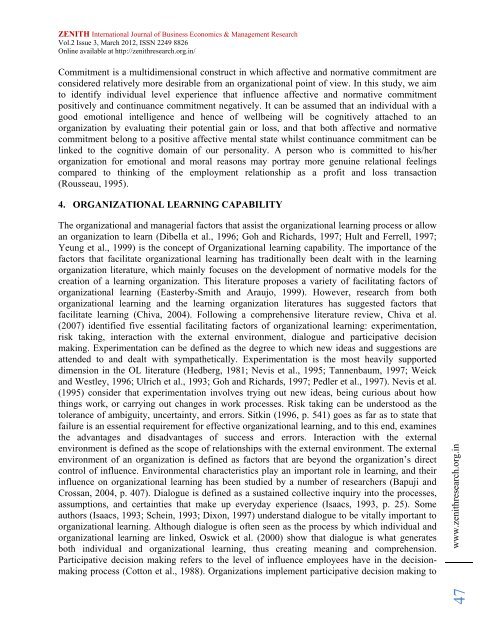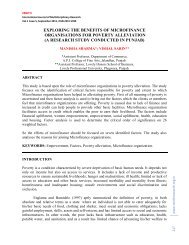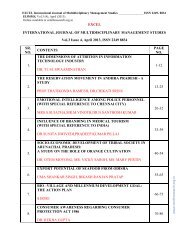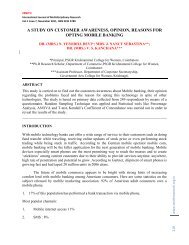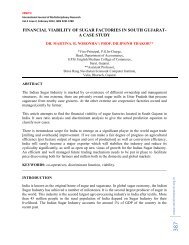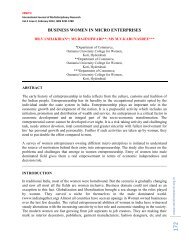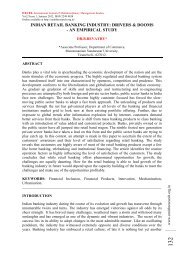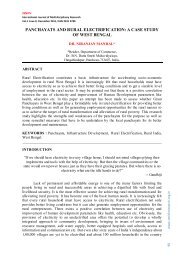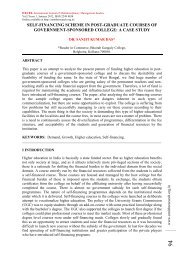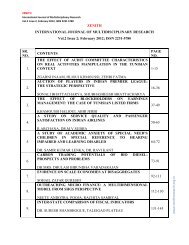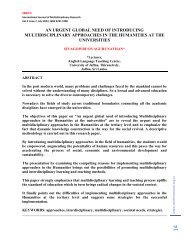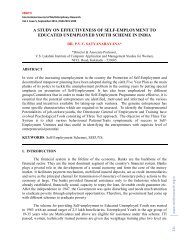ZIJBEMR MARCH 2012 ISSUE COMPLETE.pdf - zenith ...
ZIJBEMR MARCH 2012 ISSUE COMPLETE.pdf - zenith ...
ZIJBEMR MARCH 2012 ISSUE COMPLETE.pdf - zenith ...
Create successful ePaper yourself
Turn your PDF publications into a flip-book with our unique Google optimized e-Paper software.
47www.<strong>zenith</strong>research.org.inZENITH International Journal of Business Economics & Management ResearchVol.2 Issue 3, March <strong>2012</strong>, ISSN 2249 8826Online available at http://<strong>zenith</strong>research.org.in/Commitment is a multidimensional construct in which affective and normative commitment areconsidered relatively more desirable from an organizational point of view. In this study, we aimto identify individual level experience that influence affective and normative commitmentpositively and continuance commitment negatively. It can be assumed that an individual with agood emotional intelligence and hence of wellbeing will be cognitively attached to anorganization by evaluating their potential gain or loss, and that both affective and normativecommitment belong to a positive affective mental state whilst continuance commitment can belinked to the cognitive domain of our personality. A person who is committed to his/herorganization for emotional and moral reasons may portray more genuine relational feelingscompared to thinking of the employment relationship as a profit and loss transaction(Rousseau, 1995).4. ORGANIZATIONAL LEARNING CAPABILITYThe organizational and managerial factors that assist the organizational learning process or allowan organization to learn (Dibella et al., 1996; Goh and Richards, 1997; Hult and Ferrell, 1997;Yeung et al., 1999) is the concept of Organizational learning capability. The importance of thefactors that facilitate organizational learning has traditionally been dealt with in the learningorganization literature, which mainly focuses on the development of normative models for thecreation of a learning organization. This literature proposes a variety of facilitating factors oforganizational learning (Easterby-Smith and Araujo, 1999). However, research from bothorganizational learning and the learning organization literatures has suggested factors thatfacilitate learning (Chiva, 2004). Following a comprehensive literature review, Chiva et al.(2007) identified five essential facilitating factors of organizational learning: experimentation,risk taking, interaction with the external environment, dialogue and participative decisionmaking. Experimentation can be defined as the degree to which new ideas and suggestions areattended to and dealt with sympathetically. Experimentation is the most heavily supporteddimension in the OL literature (Hedberg, 1981; Nevis et al., 1995; Tannenbaum, 1997; Weickand Westley, 1996; Ulrich et al., 1993; Goh and Richards, 1997; Pedler et al., 1997). Nevis et al.(1995) consider that experimentation involves trying out new ideas, being curious about howthings work, or carrying out changes in work processes. Risk taking can be understood as thetolerance of ambiguity, uncertainty, and errors. Sitkin (1996, p. 541) goes as far as to state thatfailure is an essential requirement for effective organizational learning, and to this end, examinesthe advantages and disadvantages of success and errors. Interaction with the externalenvironment is defined as the scope of relationships with the external environment. The externalenvironment of an organization is defined as factors that are beyond the organization’s directcontrol of influence. Environmental characteristics play an important role in learning, and theirinfluence on organizational learning has been studied by a number of researchers (Bapuji andCrossan, 2004, p. 407). Dialogue is defined as a sustained collective inquiry into the processes,assumptions, and certainties that make up everyday experience (Isaacs, 1993, p. 25). Someauthors (Isaacs, 1993; Schein, 1993; Dixon, 1997) understand dialogue to be vitally important toorganizational learning. Although dialogue is often seen as the process by which individual andorganizational learning are linked, Oswick et al. (2000) show that dialogue is what generatesboth individual and organizational learning, thus creating meaning and comprehension.Participative decision making refers to the level of influence employees have in the decisionmakingprocess (Cotton et al., 1988). Organizations implement participative decision making to


